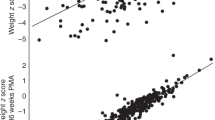Abstract
OBJECTIVE: To evaluate the influence of medical complications, gestational age, gender, ethnicity, and socioeconomic status on the changes in anthropometric measures and severity of neurologic impairment from 6 to 54 months of age in premature and term infants.
STUDY DESIGN: This study was a prospective longitudinal study to determine predictors of patterns of growth and neurologic outcome in low-risk (n=137) and high-risk (n=96) preterm infants compared to full-term infants (n=136). Growth modeling analyses were used to evaluate factors that might influence patterns of physical growth and changes in neurologic status.
RESULTS: Medical risk level was a predictor of height and head circumference at 30 months and neurologic outcome. Gender was a predictor of weight gain. Medical risk level and gender predicted 13.8% and 32% of the variance in head circumference and neurologic scores, respectively.
CONCLUSION: Medical complications after birth and gender are stronger influences than gestational age on patterns of growth and neurologic outcome.
This is a preview of subscription content, access via your institution
Access options
Subscribe to this journal
Receive 12 print issues and online access
$259.00 per year
only $21.58 per issue
Buy this article
- Purchase on Springer Link
- Instant access to full article PDF
Prices may be subject to local taxes which are calculated during checkout




Similar content being viewed by others
References
Vohr BR, Wright LL, Dusick AM et al. Neurodevelopmental and functional outcome of extremely-low-birth-weight (ELBW) infants in the NICHD Neonatal Research Network 1993–1994 Pediatrics 2000 105: 1216–26
Landry SH, Fletcher JM, Denson SE, Chapieski ML . Longitudinal outcome for low birth weight infants: effects of intraventricular hemorrhage and bronchopulmonary dysplasia J Clin Exp Neuropsychol 1993 15: 205–18
Infant Health and Development Project. Enhancing the outcomes of low-birth-weight, premature infants JAMA, J Am Med Assoc 1990 263: 267–74
Hack M, Taylor G, Klein N et al. School-age outcomes in children with birth weights under 750 g N Engl J Med 1994 331: 753–9
Saigal S, Szatmari P, Rosenbaum P et al. Cognitive abilities and school performance of extremely low birth weight children and matched term control children at age 8 years: a regional study J Pediatr 1991 118: 751–60
Koller H, Lawson K, Rose SA et al. Patterns of cognitive development in very low birth weight children during the first six years of life Pediatrics 1997 99: 383–9
Anderson A, Swank P, Wildin S et al. Modeling analysis of change in neurologic abnormalities in children born prematurely: a novel approach J Child Neurol 1999 14: 502–8
Miller CL, Landry SH, Smith KE et al. Developmental change in the neuropsychological functioning of very-low-birth-weight infants J Child Neuropsychol 1995 1: 224–36
Landry SH, Smith KE, Miller-Loncar CL et al. The relation of change in maternal interactive styles with preterm infants' developing social competence across the first three years of life Child Dev 1998 69: 105–23
Papile LA, Burstein J, Burstein R, Koffler H . Incidence and evolution of subependymal and intraventricular hemorrhage: a study of infants with birth weights less than 1,500 gm J Pediatr 1978 92: 529–34
Amiel-Tison C . A method for neurologic evaluation within the first year of life Curr Probl Pediatr 1976 7: 1–50
Baird H, Gordon E . Neurological Evaluation of Infants and Children Clinics in Developmental Medicine Philadelphia: Lippincott 1983 20–106
Swaiman K . Neurologic examination after the newborn period until 2 years of age In: Swaiman K, editor. Pediatric Neurology: Principles and Practice St. Louis: CV Mosby 1989 35–44
Wilden S, Anderson A, Woodside M et al. Prediction of 12-month neurodevelopmental outcome from a 6-month neurologic examination in premature infants Clin Pediatr 1995 34: 290–9
Littell RC, Milliken GA, Stroup WW, Wolfinger RD . SAS systems for mixed models Cary, NC: SAS Institute 1996
Bryk AS, Raudenbush SW . Hierarchical linear models: applications and data analysis methods change Newbury Park: Sage Publications 1992
Hollingshead A . Four Factor Index of Social Status New Haven: Yale University Department of Sociology 1975
Kitchen WH, Doyle LW, Ford GW, Callanan C . Very low birth weight and growth to age 8 years: weight and height AJDC 1992 146: 40–5
Author information
Authors and Affiliations
Rights and permissions
About this article
Cite this article
Morris, B., Smith, K., Swank, P. et al. Patterns of Physical and Neurologic Development in Preterm Children. J Perinatol 22, 31–36 (2002). https://doi.org/10.1038/sj.jp.7210590
Published:
Issue Date:
DOI: https://doi.org/10.1038/sj.jp.7210590
This article is cited by
-
A role for P-selectin and complement in the pathological sequelae of germinal matrix hemorrhage
Journal of Neuroinflammation (2023)
-
Calculating postnatal growth velocity in very low birth weight (VLBW) premature infants
Journal of Perinatology (2009)


